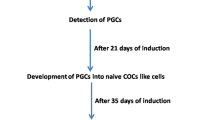Abstract
Purposes
Clinical application of human embryonic stem cells will be possible, when cell lines are created under xeno-free and defined conditions. We aimed to establish methodologies for parthenogenetic activation, culture to blastocyst and mechanical isolation of the inner cell mass (ICM) using bovine oocytes, as a model for derivation and proliferation of human embryonic stem cells under defined xeno-free culture conditions.
Methods
Cumulus-oocyte-complexes were in vitro matured and activated using Ca2+Ionophore and 6-DMAP or in vitro fertilized (IVF). Parthenotes and biparental embryos were cultured to blastocysts, when their ICM was mechanically isolated and placed onto a substrate of fibronectin in StemPro® medium. After attachment, primary colonies were left to proliferate and stained for pluripotency markers, alkaline phosphatase and Oct-4.
Results
Parthenogenesis and fertilization presented significantly different success rates (91 and 79 %, respectively) and blastocyst formation (40 and 43 %, respectively). ICMs from parthenogenetic and IVF embryos formed primary and expanded colonies at similar rates (39 % and 33 %, respectively). Six out of eight parthenogenetic colonies tested positive for alkaline phosphatase. Three colonies were analyzed for Oct-4 and they all tested positive for this pluripotency marker.
Conclusion
Our data show that Ca2+ Ionophore, and 6-DMAP are efficient in creating large numbers of blastocysts to be employed as a model for human oocyte activation and embryo development. After mechanical isolation, parthenogetic derived ICMs showed a good rate of derivation in fibronectin and Stem-Pro forming primary and expanded colonies of putative embryonic stem cells. This methodology may be a good strategy for parthenogenetic activation of discarded human oocytes and derivation in defined conditions for future therapeutic interventions.


Similar content being viewed by others
References
Amit M, Shariki C, Margulets V, Itskovitz-Eldor J. Feeder layer- and serum-free culture of human embryos stem cells. Biol Reprod. 2004;70:837–45.
Bhak JS, Lee SL, Ock SA, Mohana Kumar B, Choe SY, Rho GJ. Developmental rate and ploidy of embryos produced by nuclear transfer with different activation treatments in cattle. Anim Reprod Sci. 2006;92:37–49.
Cao S, Wang F, Chen Z, Liu Z, Mei C, Wu H, Huang J, Li C, Zhou L, Lui L. Isolation and culture of primary bovine embryonic stem cell colonies by a novel method. J Exp Zool. 2009;331A:368–76.
Ellerström C, Strehl R, Moya K, Anderson K, Berch C, Lundin K, Hyllner J, Semb H. Derivation of a xeno-free human embryonic stem cell line. Stem Cells. 2006;24:2170–6.
Ferreira RM, Ayres H, Chiaratti MR, Ferraz ML, Araújo AB, Rodrigues CA, Watanabe YF, Vireque AA, Joaquim DC, Smith LC, Meirelles FV, Baruselli PS. The low fertility of repeat-breeder cows during summer heat stress is related to a low oocyte competence to develop into blastocysts. J Dairy Sci. 2011;94:2383–92.
Ilic D, Stephenson E, Wood V, Jacquet L, Stevenson D, Petrova A, Kadeva N, Codognotto S, Patel H, Semple M, Corwell G, Ogilvie C, Braude P. Derivation and feeder-free propagation of human embryonic stem cells under xeno-free conditions. Cytotherapy. 2012;14:122–8.
Mai Q, Yui Y, Li T, Wang L, Chen M-J, Huang S-Z, Zhou C, Zhou Q. Derivation of human embryonic stem cell lines from parthenogenetic blastocysts. Cell Res. 2007;17:1008–19.
Méo SC, Yamazaki W, Ferreira CR, Perecin F, Saraiva NZ, Leal CL, Garcia JM. Parthenogenetic activation of bovine oocytes using single and combined strontium, ionomycin and 6-dimethylaminopurine treatments. Zygote. 2007;15:295–306.
Noaksson K, Zoric N, Zeng X, Rao MS, Hyllner J, Semb H, Kubista M, Sartipy P. Monitoring differentiation of human embryonic stem cells using real-time PCR. Stem Cells. 2005;23:1460–7.
Tannenbaum SE, Turetsky TT, Singer O, Aizenman F, Kirshberg S, Ilouz N, Gil Y, Berman-Zaken Y, Perlman TS, Geva N, Levy O, Arbell D, Simon A, Ben-Meir A, Shufaro Y, Laufer N, Reubinoff BE. Derivation of xeno-free and GMP-grade human embryonic stem cells – platforms for future clinical applications. PLoS One. 2012;7:e35325.
Thompson JA, Itskovitz-Eldor J, Shapiro SS, Waknitz MA, Swiergiel JJ, Marshall VS, Jones JM. Embryonic stem cell lines derived from human blastocysts. Science. 1998;282:1145–7.
Van De Velde A, Liu L, Bols PE, Ysebaert MT, Yang X. Cell allocation and chromosomal complement of parthenogenetic and IVF bovine embryos. Mol Reprod Dev. 1999;54:57–62.
Wang ZG, Wang W, Yu SD, Xu ZR. Effects of different activation protocols on preimplantation development, apoptosis and ploidy of bovine parthenogenetic embryos. Anim Reprod Sci. 2008;105:292–301.
Winger QA, De La Fuente R, King A, Armstrong DT, Watson AJ. Bovine parthenogenesis is characterized by abnormal chromosomal complements: implications for maternal and paternal co-dependence during early bovine development. Dev Genet. 1997;21:160–6.
Paffoni A, Brevini TA, Somigliana E, Restelli L, Gandolfi F, Ragni G. In-vitro development of human oocytes after parthenogenetic activation or intracytoplasmic sperm injection. Fertil Steril. 2007;87:77–82.
Jin M, Wu A, Dorzhin S, Yue Q, Ma Y, Liu D. Culture conditions for bovine embryonic stem cell-like cells isolated from blastocysts after external fertilization. Cytotechnology. 2012;64:379–89.
Author information
Authors and Affiliations
Corresponding author
Additional information
Capsule
Bovine parthenotes may be used as a model for the creation of human embryonic stem cells derived and cultured under defined conditions.
Rights and permissions
About this article
Cite this article
Ruggeri, R.R., Watanabe, Y., Meirelles, F. et al. The use of parthenotegenetic and IVF bovine blastocysts as a model for the creation of human embryonic stem cells under defined conditions. J Assist Reprod Genet 29, 1039–1043 (2012). https://doi.org/10.1007/s10815-012-9866-z
Received:
Accepted:
Published:
Issue Date:
DOI: https://doi.org/10.1007/s10815-012-9866-z



